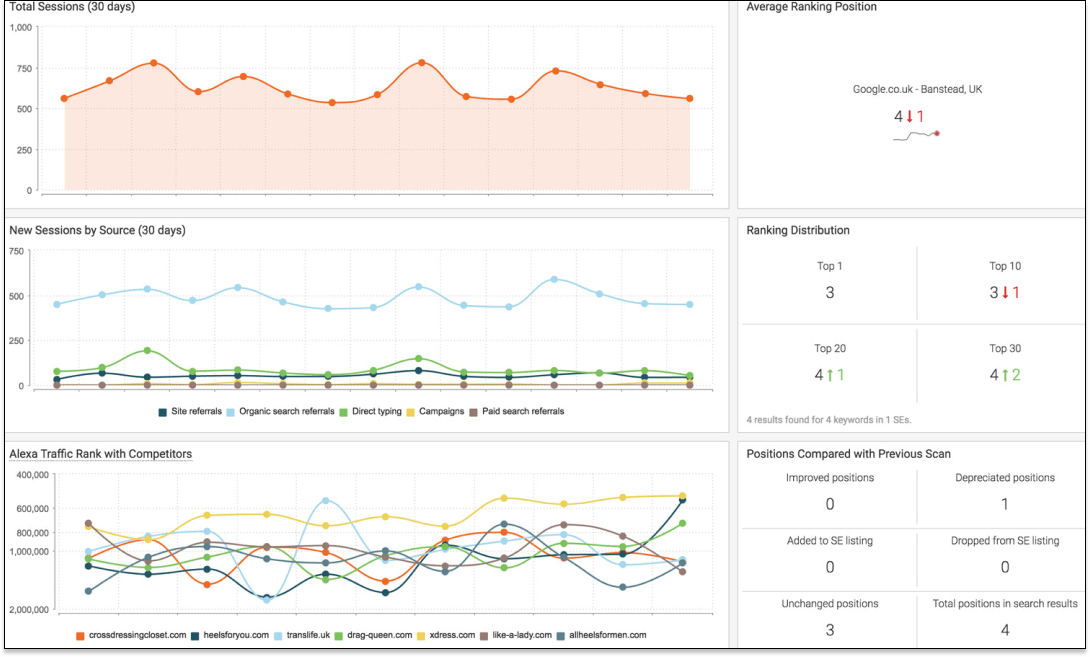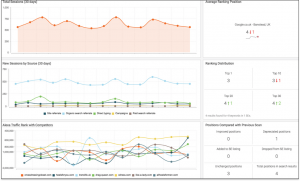Shopify has become one of the biggest eCommerce platforms in the world. Nearly one in three online businesses in the USA use Shopify to power their online stores. But what happens after the store is set up? How can merchants reach potential customers and make them choose their stores above the others?
That’s where search engine optimization comes in. Search engine rankings play an important role in helping shoppers find your Shopify store. Successful SEO is key. The higher your eCommerce store ranks in search results, the more traffic it will generate.
Since Printify offers Shopify integration and it’s one of the go-to platforms for our merchants, it is our duty to provide useful tips, tricks, guidelines, and helpful information for SEO improvements. Use our Shopify SEO guide to optimize your Shopify store and attract more traffic and customers worldwide.
What Is Shopify SEO & Why Is It Important?
Shopify SEO is a set of SEO tools and adjustments unique to the specific platform. Shopify helps merchants set up their stores in a quick and easy manner. When it comes to SEO, merchants need to be extra sharp and use all the tools available for ultimate optimization to ensure excellent search engine performance.
Research your competitors, current trends, and customer needs and preferences. Use quality content and advertise on other platforms to attract more traffic and attention to your Shopify store. While the platform already comes with useful SEO tools, such as a blog and redirection, it can create multiple SEO issues. Learn to optimize Shopify SEO to avoid problems and reach SEO success.
What Are the Biggest SEO Issues With Shopify?
While the Shopify site is already powerful for Google search and provides SEO-friendly options, there are some issues users have encountered.
Duplicate Product Pages
As store pages get bigger, one of the most common SEO problems for Shopify is the handling of products with different variations, which creates duplicate content. Products exist on multiple pages or URLs in the Shopify online store. If both pages rank for similar keywords, search engines get confused and don’t know which page to send the traffic to.
To solve this, Shopify has added canonical URLs. If two different URLs show the same product, choosing one as a canonical URL will tell the search engines which product page to show in the search result.
Long URLs
Some store owners have an issue with the page URL structure that Shopify provides. It uses a subfolder-based system, making long, inconvenient URLs. Currently, there is nothing you can do about it. However, Shopify is taking feedback into consideration and is already making improvements.
In the meantime, there are several steps you can take as a merchant to improve your website SEO, rank high among other eCommerce sites, and boost organic traffic with multiple SEO resources, and free tools.
Make It Happen Today!
8 Different Ways to Improve Your Shopify SEO and Sell More
1. Optimize Your Online Store’s Structure

Optimizing your content and eCommerce site structure is one of the most important steps. Pages need to be simple and easy to understand. Buyers have to be able to find everything they need and navigate the site with zero problems and confusion.
Structure
Set up a structure that has a sense and order. Organize content in a few simple category pages and don’t lead customers too far from the home page. No one wants to get lost in a maze of links and sub-categories while looking for a single item.
We suggest a site structure with Home Page > Category Page > Product Page. This will create a positive user experience and help searches rank product pages higher than competitors in the search results.
Internal Links
Add internal links to promote the most important pages of your online shop. Google uses links to rank content in search results for different Shopify sites. The more links a page has, the more it indicates to Google and other search engines the importance of the article.
Site owners can control internal linking and guide shoppers and search engines to the most essential pages. Link to a specific page using anchor words. Choose good ones and notify search engines of what the link will lead to. Shine amongst other Shopify store owners by linking to what’s important.
Navigation
Help users navigate your Shopify site by straightforward and recognizable terms, page names, and destinations. Everything should properly describe where the click will lead them. List the most important pages and send customers directly where they need or want to be.
Amongst other pages, include a search bar, Contacts, and an About Us page. Informational pages help you build credibility and connections, as well as rank the store higher in searches.
2. Do Research About the Right Target Keywords
Search engine optimization is all about keywords. To rank high on search engines, you need to know the specific keywords people are searching for and add them to your Shopify site. To gather the necessary information, you’ll have to perform research on keywords.
There are multiple resources and ways for researching and improving Shopify SEO for your online store, from a simple keyword research tool to the buyers themselves. Let’s look at some options and more resources for keyword ideas and research.
- Buyer Personas. Put yourself in the shoes of the shoppers. What search terms would you type into the search engine to find the products your store is selling? What do your target customers care about? What are their values, needs, wishes, and hobbies?
- Social Media. Use social media channels like TikTok, Instagram, or Facebook for the ultimate keyword research. Search for products similar to yours and explore the hashtags and terms being used to describe them.
- Competitors. How do they attract customers and traffic to their stores? What keywords do they use in their web pages, meta tags, page titles, and meta descriptions? What is the ranking factor for them?
- SEO Tools. Search engines understand what keywords people look up the most. Use tools like Google Trends and Google Analytics, or trustworthy paid services like Ahrefs to explore the current trends and searches around the world.
3. Improve the User Experience
User experience is another important factor that will determine the future success of your store. Sell not only products online but excellent customer service and user experience to promote brand awareness and attract more people to your site.
The above-mentioned tips for structure and navigation are already great improvements to the way your site is used. If people can easily understand and find what they are looking for, without getting confused or lost in different pages, chances are they will return and recommend the store to others.
Responsive Design. Make your store look great on all devices, including phones, tablets, and desktops to improve shopping on Shopify apps. Use responsive Shopify themes to increase the time spent on your site, as Google also uses that to rank you higher. Higher rankings lead to bigger traffic and more conversions.
4. Improve the Speed of Your Website
When a customer goes to a blog post or clicks on a specific website, they don’t want to wait for ages for it to load. Frustration will most likely lead to them abandoning the website and never coming back. That’s why it is important to optimize your Shopify store speed.
- Choose a highly optimized theme or build one according to your specifications.
- Use small, optimized images that are lighter and will load easily. We suggest Jpegs.
- Avoid a large number of apps on the website. Get rid of everything you don’t need.
- Avoid sliders.
5. Have a Blog Section and Create Content


Blogging is a good asset for boosting Shopify SEO. Increase your shop’s visibility on Google with content marketing and blog posts surrounding keywords. Let the buyers know what your site is all about by starting a blog. Go to Online Store > Blog posts and get creative.
Shopify already comes with a basic blogging engine that allows merchants to start their blogs in a few simple clicks. Blogging can help stores reach a wide audience through search engines if the content is created around target keywords and adjusted to the specific niches of the business.
Come up with a good content strategy and optimize your website to the fullest. Determine what the main goal is for your blog. What type of content do you want to share? What will it do? Will it attract new customers? Expand the bond with existing ones? Will it build brand awareness? Come up with content that will resonate with buyers and their journey on your website.
6. Write Unique Product Descriptions
Product descriptions are the next most important assets to your listings after photography and titles. A good product description will help you stand out from the competition, increase SEO rankings and your chances of actually selling a product.
How to write a good product description:
- Focus on the buyer personas. Directly address the needs of your customers.
- Highlight benefits over features. Not all customers care about features as much as benefits. Benefits are what makes your product different from others.
- Use basic language. Product descriptions need to sound like a real, natural conversation, not a computer-generated one.
- Make it short. Write short, straight to the point, easy-to-read product descriptions with some bullet points or short paragraphs.
- Include social proof. Add customer reviews and ratings on product pages to assure the quality of your offers.
- Optimize with search engines. Add useful and popular keywords in the description to boost traffic and ranking on search engines.
- Good product images. Keep in mind the quality of the image, zoom, and add multiple angles of the product to give a clear perspective of the item to the customer.
Pro tip: partner with Printify and use our high-quality product preview images and detailed descriptions on your Shopify store to ensure the best results for your products.
7. Write Engaging Page Titles and Meta Descriptions
The page title and meta description should be just as engaging, precise, and excellent as the product description. Set the perfect page title and meta description to skyrocket your rankings on any search engine when it comes to your products and your Shopify store.
Shopify provides templates that automatically generate titles and descriptions, but you can edit those to your liking and boost your Shopify SEO, moving your store higher up on the search results with data and well-planned keywords.
Keep in mind that meta titles and descriptions are only for the search results. They will differ from the regular ones that appear on your product page. Let’s take a look at what is what, and how to optimize everything.
Meta Title
The meta title is a title that appears in search results when someone looks for specific terms regarding your product. How to write meta title:
- Make it relevant to the content of the page.
- Make the headline (h1 tag) different from the title tag.
- Optimal length – up to 60 characters, including spaces.
- Use primary keywords in the title.
- Use brand names at the end of the title.
Meta Description
The meta description is a short description that appears in search results, explaining what the link contains. How to write meta description:
- Write it as intriguing and interesting as possible to attract the most attention and clicks.
- Use keywords and keyword phrases in your meta descriptions to optimize SEO.
- Optimal length – about 160 characters for web search, 120 for mobile.
- The description has to be readable and convey the main purpose of the site.
8. Get Backlinks
Backlinks are links posted on other sites that send the user to your page. They have a huge impact on the search ranking, as search engines use backlinks to determine how the wider audience values your Shopify site. They establish brand credibility and trustworthiness. Getting backlinks is not easy, but the effort is worth it.
How to get links to your store?
- Publish Strong Content. Strong, valuable content attracts backlinks without reaching out, since people like linking to interesting and reliable content.
- Publish Guest Posts. By publishing on high-ranking websites, you will automatically earn backlinks.
- Reach Out. Contact bloggers, influencers, and review websites. Ask them to review your products.
- Mentions. Maybe your store has already been mentioned without a backlink. Use mention.com to find out possible mentions and email them asking for a link to your store.
- Manufacturer and Supplier Links. Established companies might have a policy for retailers to get a link. Email them and ask for it.
- Broken Links. Search for broken links for products similar to yours. Reach out to the owner of the site with the broken link and ask them to link to your store instead.
Pro tip: as tempting as it is, avoid buying links. It can result in penalties and wrecking your website.
Make It Happen Today!
What Are the Best SEO Apps for Shopify?
There are plenty of choices out there, depending on your preferences, needs, price range, and other criteria. Let’s take a look at some of the best SEO apps for Shopify, based on their features, price range, and more.
Smart SEO
Main Features:
- Fixes 404 Errors
- Generates Meta Tags
- Generates Alt Tags
- Multi-Language Support
- Sitemap Integration
- Broken Link Management
- Removes Microdata
- On-Site SEO Optimisation
Pricing: Free plan / Pro plan for $4.99 per month
This app automatically generates tags for all the listings on your store. Smart SEO helps increase traffic, helps search engines find your store and improve its ranking by providing structured data in JSON-LD format. It’s an intelligent, helpful tool that ensures your store and all its features are in good shape.
The app will manage sitemap support, regularly scan the store page for broken links, and automatically fix issues at the same time. The app is easy to use, even in multiple languages. It’s a definite go-to option for optimizing Shopify SEO.
SEO Manager
Main Features:
- SEO Issues Scan and Suggestions
- Google Trends Integration
- 404 Error Management and Repairs
- Google Search Console Integration
- Redirect on “Out of Stock”
- Sitemap Management
- Advanced Meta Settings
- Google PageSpeed Integration
- Index/No Index
- Image ALT Text Issues Scan
Pricing: 7-day free trial / $20 per month
This app is especially good for SEO beginners, as it provides a step-by-step guide on how to improve a site and its performance. SEO Manager comes with 20 features, testing the overall performance of your site, fixing errors, and giving relevant feedback.
The app helps increase your store rankings on search results and allows creating custom meta tags, titles, descriptions, and keywords. It provides many templates to work with and helps with suggestions on how to improve your SEO game.
SEOMetriks
Main Features:
- Keyword Research
- Technical Audit
- Sitemap Generation
- SEO Analysis
- Excellent Support
- Competitor Metrics
- Rank Tracking
- Social Engagement Tool
- Link Optimization
- Google Web Search
Pricing: $7.99 per month
This app offers users a total of 15 tools for optimizing their websites for maximum results. Using intel from such main SEO players as Majestic, MOS, and SEMrush, you have the access to information from more than 370 global and local SEO data storages, which are constantly updated and monitored.
SEOMetriks provides site rankings, backlink analysis, stats on competitor pages regarding traffic and rankings, and more. You can track your performance on social media platforms, as well as the latest keywords in your niche. Apply them to your product catalog and immediately boost your Shopify SEO.
Plug In SEO
Main Features:
- Structured Data (JSON-LD)
- Updates Along With Search Engines
- Fixing SEO Issues
- Generates Meta Titles
- Generates Meta Descriptions
- ALT Tags
- Google Search Console Integration
- Keywords Tools
- Broken Link Management
- Fixing Errors
- Multilingual SEO
- SEO for collection pages, search, filters, tags
Pricing: Free edition / 7-day free trial / Plug In SEO Plus for $20 per month
The free edition helps with basic SEO optimization, checking for and solving SEO issues with the integrated smart analyzer. The Plug In SEO Plus is for more advanced users who want to explore SEO optimization to the fullest. The app is easy to use and comes with everything you need for SEO.
Powerful optimization tools, excellent technical SEO support, SEO training videos with useful information, tips, and tricks on how to stay on top of the competitors. This is an all-in-one app that provides tools for analyzing, fixing, and optimizing your Shopify store’s SEO.
Reload SEO
Main Features:
- Beginner Friendly
- Keyword Research in Shopify
- SEO Performance Dashboard
- Backlink Analysis
- Competitor Content and Traffic Analysis
- Content Optimization
- Keyword Tracking
- Shopify Store Monitoring
Pricing: 14-day free trial / $14.95 per month
Reload SEO is a beginner-friendly app made for anyone with a Shopify store. Whether you know all about keyword research, text conversion and optimization, or are completely new to the SEO world, this app will make sure your store improves the overall performance and ranking.
Analyze competitor content, boost your performance, rank high in searches, and attract traffic with Reload SEO. It provides keyword research, suggestions, tips, and tricks on how to beat the competition, as well as keyword rankings for desktop and mobile devices in over 170 countries. A great tool to have for stores with an international client base.
Conclusion
Optimizing SEO is important for every store owner, as it helps to boost traffic, rank higher on search pages, and increase credibility, authority, and popularity among competitors. While there are plenty of helpful apps that do it all for you, don’t forget there are several steps you can take to improve Shopify SEO yourself:
- Optimize Your Store’s Structure
- Do Research About the Right Target Keywords
- Improve the User Experience
- Improve the Speed of Your Website
- Have a Blog Section and Create Content
- Write Unique Product Descriptions
- Write Engaging Page Titles and Meta Descriptions
- Get Backlinks.
From a good page title, keywords, top-notch category pages, meta titles and descriptions, to researching competitors and getting help from professional SEO apps. Use this Shopify SEO guide to boost your rankings, traffic, and overall performance. Improve Shopify SEO and sell more.
Make It Happen Today!
The post 8 Ways to Improve Shopify SEO for Your Online Store appeared first on Printify.









